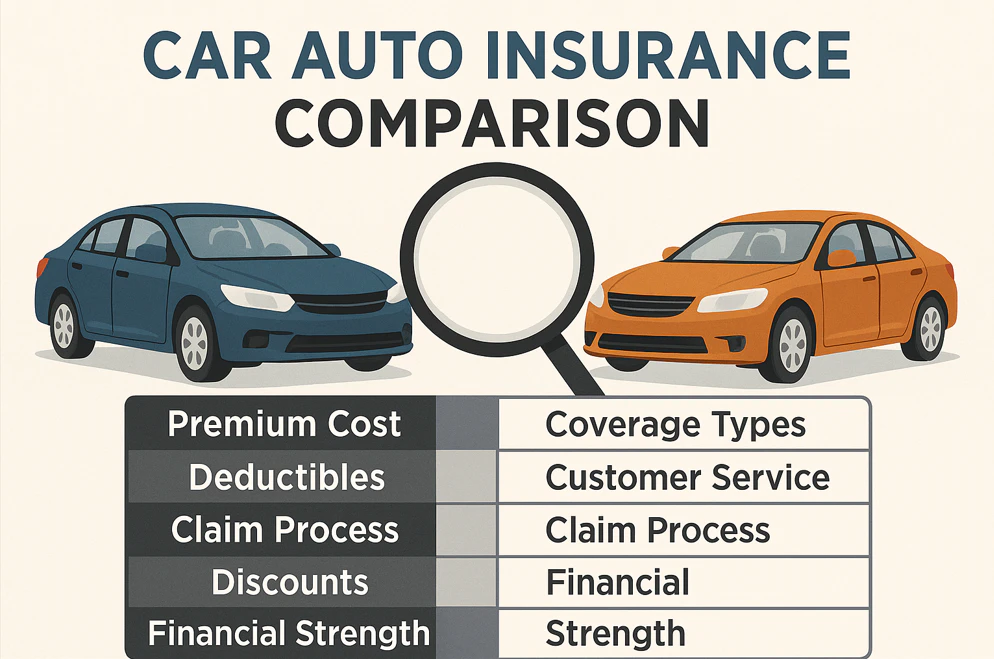Car Auto Insurance Comparison: How to Find the Best Coverage at the Best Price
With rising premiums and countless providers, finding the right car insurance at an affordable rate can feel overwhelming. That’s why a well-executed car auto insurance comparison is one of the smartest moves a driver can make.
Whether you’re shopping for your first policy or looking to switch providers, comparing quotes can help you uncover hidden discounts, improve coverage quality, and ultimately save money.
According to the National Association of Insurance Commissioners (NAIC), insurance pricing can vary significantly from one company to another—even for the exact same driver profile. That’s why it’s crucial to take a data-driven approach to comparing policies.
Consumer advocates like Consumer Reports emphasize the importance of reviewing customer service, claims satisfaction, and transparency alongside cost when choosing a policy. It’s not just about finding the cheapest premium—it’s about value.
What Does Car Insurance Comparison Mean?
Car insurance comparison involves analyzing quotes from multiple providers to find the best match for your coverage needs and budget. Most drivers use:
- Online comparison tools
- Licensed agents
- Direct quotes from insurer websites
By using these options, you can weigh multiple offers at once, helping you avoid overpaying or underinsuring.
Why You Should Compare Car Insurance Regularly
Many drivers assume loyalty will reward them—but insurers often raise rates year over year. Here’s why you should always compare before you renew:
- Premiums vary dramatically—even for the same driver, car, and coverage
- Discounts and promotions change throughout the year
- Some insurers offer better rates for specific risk profiles (e.g., low-mileage, good credit)
- You may qualify for new discounts you weren’t eligible for before

What to Look for When Comparing Auto Insurance
When evaluating quotes, don’t just glance at the price tag. Consider these key components:
- Coverage type and limits
- Deductibles (higher deductibles = lower premiums, but more out-of-pocket)
- Policy exclusions and fine print
- Discounts (multi-car, good driver, bundling, anti-theft devices)
- Customer support and claims reviews
- Financial strength ratings (A.M. Best, Moody’s)
Pro tip: Always compare apples to apples—same vehicle, same driver, same coverage.
Types of Coverage You’ll Be Comparing
Insurance policies can be simple or complex, depending on what you need. Make sure to evaluate:
- Liability insurance: Covers damage to others when you’re at fault
- Collision coverage: Pays for damage to your car in a crash
- Comprehensive coverage: Covers theft, fire, hail, vandalism, etc.
- Uninsured/underinsured motorist: Protects you from drivers with inadequate coverage
- Personal injury protection (PIP) or MedPay: Covers your medical expenses regardless of fault
- Add-ons: Roadside assistance, rental reimbursement, gap coverage
Best Tools for Car Auto Insurance Comparison
Want fast, side-by-side quotes without the hassle? These tools make it easy:
- The Zebra – User-friendly and pulls quotes from 100+ insurers
- NerdWallet – Combines reviews, guides, and quote tools
- Compare.com – Transparent pricing across a broad network
- Policygenius – Ideal for bundling home and auto insurance
✅ Advantages:
- Quick and easy
- Saves time calling multiple insurers
- Helps filter options based on personal needs
⚠️ Things to Watch:
- Not all insurers are listed on every platform
- Some require phone or email follow-up
Tips to Get the Most Accurate Quote
Ensure your quote is based on accurate, real-world information:
- Know your VIN and current mileage
- Disclose all accidents and tickets in the past 3–5 years
- Maintain a good credit score, which many insurers consider
- Be honest about how often and how far you drive
- Match coverage limits and deductibles for all quotes
Common Mistakes to Avoid
Many drivers unknowingly leave money on the table or buy inadequate coverage. Watch out for these:
- Only comparing premiums, not full policy details
- Over-insuring or under-insuring your car’s actual value
- Ignoring customer service reputation
- Not asking about hidden fees or exclusions
- Failing to update quotes after life changes (marriage, job, move)
When Should You Re-Compare Your Policy?
You don’t have to wait until your renewal date to shop around. In fact, the best time to compare may be:
- After a significant life event (marriage, buying a new car, moving)
- When your credit score improves
- After filing or resolving a claim
- When adding or removing a vehicle or driver
- When your current premium increases unexpectedly
Frequently Asked Questions (FAQs)
What’s the best website to compare auto insurance?
There’s no single best site, but platforms like The Zebra, Policygenius, and NerdWallet offer broad access to real-time quotes, customer reviews, and policy insights.
Is it cheaper to buy online or through an agent?
Online quotes are often cheaper due to exclusive discounts and lower administrative costs, but agents may offer more personalized advice and help bundle policies.
How do I make sure quotes are accurate?
Use the same vehicle, driver, and coverage information across all providers. This helps ensure consistency and accuracy in your comparisons.
Will comparing quotes affect my credit?
Most platforms use a soft credit check, which doesn’t affect your credit score. However, once you apply for a policy, an insurer may run a full check.
How often should I shop around?
At least once a year, or any time your circumstances change significantly.
Final Thoughts
Car auto insurance comparison is one of the most effective ways to save money without sacrificing protection. By investing a little time upfront, you can uncover better deals, more robust coverage, and peace of mind.
Remember:
- Use reliable tools and resources like NAIC and Consumer Reports
- Compare based on more than just price
- Keep your information consistent and accurate
By being proactive, you take control—not just of your car, but of your financial future.